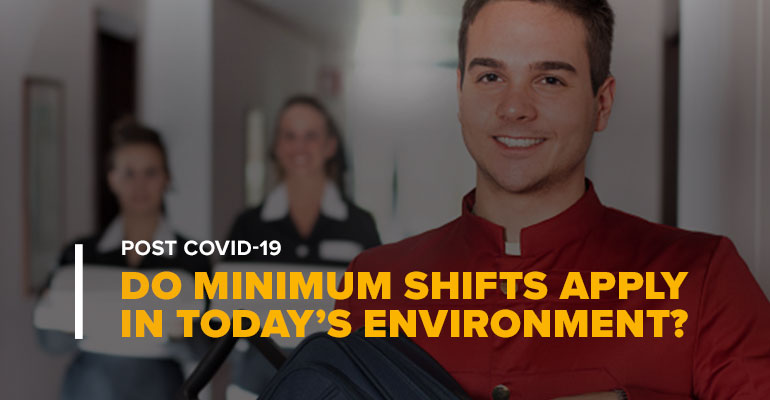April 30, 2020 - Forty plus years ago when I began consulting in the hospitality industry, one of the first questions we would ask an operator was, “How many people does it take to open your doors?” The answer varied depending on the type of operation, the operation’s market position, and the complexity of the operation. The key though, was that everyone thought in terms of bodies needed, typically for eight-hour shifts.
Through the years, that answer has basically stayed the same – and candidly, so has the question. This thinking probably originated in manufacturing industries where much of the work is team oriented. By team oriented I mean you work on a production line with a group of individuals, each having a specific task to complete before the next person can complete his or her task. Henry Ford became famous for creating this high-productivity manufacturing model, and the interdependence of the staff required scheduling full shifts with fixed positions. A production line with eight stations simply needed eight people to operate. Seven was too few. Nine too many. Eight was just right, like the porridge in the Goldilocks story.
As production lines became the standard for manufacturing, hospitality was clearly at a different stage in its development. Most hospitality operations were smaller and run by families who, with the help of some staff, pretty much did everything. There were very few, if any, specific work positions as staff members did multiple things during the day. Then big hotels and corporate operators came along, and running a larger operation became more complex. As they looked for ways to simplify operations efficiently, they adopted Henry Ford’s fixed-position model to make it easier to manage the business. The mindset became, “I need two servers to open the restaurant; two Bellman; two desk clerks; two line cooks; two stewards/dishwashers” and so on.
As businesses grew, additional staff was added based on volume but minimum staff thinking has remained. Interestingly, unlike a production line, the two bell persons’ work does not deter or advance the work of the front desk clerk. In many ways, most of the positions in a hotel are independent. You could look at the total guest experience, from one interaction to another, as a quasi-production line but the interdependency of each role is not the same as the eight-person manufacturing line.
Given this, how does today’s environment demand different thinking? One key consideration in the near term is that, as consumers begin to determine how they will navigate a post-quarantine world, volumes will likely remain abnormally low. Even as they increase, rates paid for a room or a main course in a restaurant will be low and grow at a slower rate than volume. This means that the answer to the age-old question “how many people does it take to open your doors”, needs to change. At low volumes and low rates, today’s financial projections and results demand a new question and a new way of thinking. That new question is, “What are the minimum tasks I need to do to meet customer needs and requirements in this financial reality?”
Let’s look at a few examples of a change in thought process.
| Old Way of Thinking | New Way of Thinking |
| I need one public cleaner | Lobby cleaning per shift is 3 hours |
| I need one dishwasher and one potwasher | Dishwashing takes 2.5 hours; Potwashing takes 1.75 hours |
| I need two servers and one busperson | Server=4 hours, Bus=1.5 hours |
These are just a few examples of the new requirements for thinking about labor needs. Primarily, this focus needs to be around task requirements not fixed-position requirements. By looking at task requirements, which then convert to staffing needs, cross-utilization becomes more obvious and easier to apply. At low occupancy and rates, each hour of staff time becomes more critical in the value equation than at high occupancy and rates, where many times there is built-in time that is not contributing to the value equation.
Some of these concepts will not be foreign to limited service, more simple properties. The person who cleans or touches up the lobby also cleans rooms or works in the laundry. They may even pick up used linen from the housekeepers. But in larger, more complex operations, more specialization occurs and will continue to occur unless we change our thinking.
To accomplish this paradigm shift, one has to look at the tasks that make up the job. For example, what are the tasks, frequency at different volumes, and time needed to meet established end-product standards for a lobby porter. This is not a simple undertaking, but if done properly for all activities in the operation with appropriate adjustments for volume changes and rate, operating losses can be reduced and the profit gap can be closed much more quickly.
Once completed, cross-utilized jobs will become self-evident and easy to apply. Some simple examples follow:
- Bell person spot cleans the lobby and door handles.
- Dishwasher and bus person are combined.
- Front desk clerk is host for lunch.
- Housekeepers work part of the day in the laundry.
There are many opportunities to meet guest expectations by starting with a focus on what tasks need to be done to open the doors.
Finally, to effectively accomplish these job combinations and fully cross-utilize staff, an advanced Labor Management / Scheduling System can essentially automate much of the planning and performance assessment process. Once forecasts are completed and the proper indicators are made available to the system, managers will simply need to review and sign off on a schedule that was automatically developed for them using smart technology that handles the complex algorithms.
The days of “how many shifts do I need for which positions” to open the doors are past. A focus on “what are the minimum tasks required” will dramatically enhance the recovery period as consumers’ confidence in their safety returns and guest volumes return to a profitable scale.






